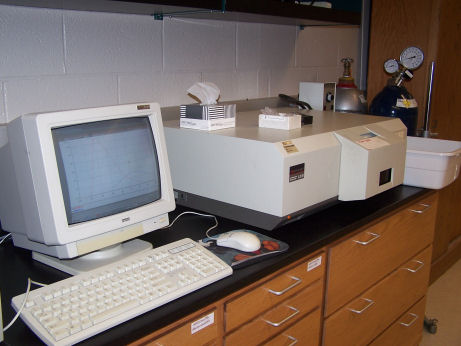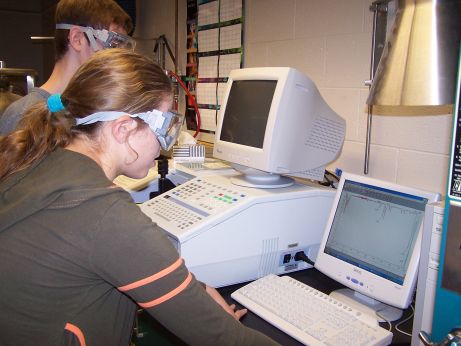Molecular Spectroscopy

Perkin-Elmer Fluorimeter
Fluorimetry
When a molecule is exposed to light, some of it can be absorbed and one of the molecule's electrons are excited in the process. As the amount of light that a solution absorbs is proportional to the concentration of the molecule absorbing it, it is possible to use this technique to measure concentrations.
Fluorimetry is similar in spirit to the experiment described above, but much more sensitive. In an absorption experiment, a beam of light is passed through a sample and a relatively small fraction of that light is absorbed. That difference can then be related to the sample's concentration. In contrast, a fluorimeter shines a beam of light through the sample which will excite those molecules. When the excited electrons return to the ground state, they radiate light of the energy that they had absorbed. Thus, instead of measuring the fraction of light absorbed, a fluorimeter measures the amount of radiated light.
Infrared Spectroscopy
An infrared spectrum measures the vibrational frequencies of a molecule. Each "functional group" within the molecule (such as an alcohol group or a carbonyl group) absorb light at a particular frequency. Thus, this experiment tells you what functional groups exist within your molecule--a large step toward determining its structure.
The department houses: 2x Perkin Elmer 1600 Series FTIR Spectrometers (one ATR cell), Jasco FTIR with ATR Cell, Perkin Elmer Spectrum RX-1 FTIR Spectrometer with ATR accessory, Applied Systems React IR 1000

Perkin Elmer Spectrum RX-1 FTIR Spectrometer with ATR accessory
UV-VIS Spectrometry
The department also owns several UV-VIS Spectrometry. 3 Shimadzu 1601 systems (one with UV probe and software control) and a OLIS (Cary-14)
